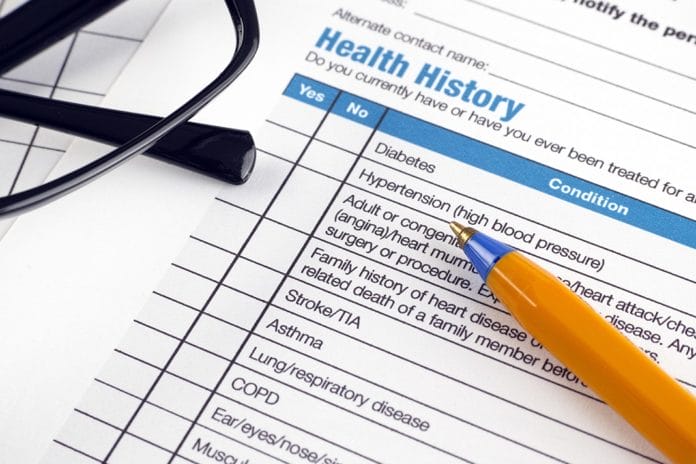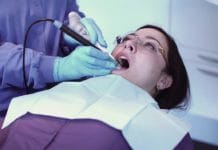Treating a patient in the clinical setting is so much more than just sitting down and scaling teeth. There are pockets to measure, small talk to be made, infection control protocol to maintain, educational information to pass along, a bit of detective work/patient assessment, radiographs to expose, treatment plans to discuss, consent to obtain for additional services, and that’s not even the end of it.
So much is packed into the hour (or less) which is allotted for each patient, it becomes easy to gloss over things in order to keep the schedule on track. Unfortunately, the task of obtaining or updating a patient’s health history tends to end up in this category. This critical task often gets truncated to a single call-and-response between the hygienist and the patient:
RDH: Any changes in your health history?
PATIENT: No, none that affect my teeth.
RDH: Okay, thanks.
As health care professionals, we all want to do the best for our patients. We want them to have the best dental education, receive the best treatment, and have a healthy mouth and body. We want to believe they are healthy when they say they are. But are we allowing ourselves to create a dangerous situation by getting stuck in the script when reviewing our patients’ health histories?
The Center for Disease Control (CDC) ranks accidents/unintentional injuries as the #3 leading cause of death in the United States. This includes accidents stemming from medical errors.1 So, are a couple of extra seconds to really be sure we are getting an accurate health history update worth the appointment time? Absolutely.
When I was a new hygienist, less than a year out from graduation, I had a patient in general practice, whom I will call Larry. I will never forget this man; in his mid-fifties, slightly overweight, salt and pepper hair, with a fairly standard health history page in his chart. He reported medications for high blood pressure and cholesterol and taking a multi-vitamin, nothing particularly outstanding to be found.
I asked Larry my health history update question, he gave a null response, so I proceeded on with the appointment. Something nagged at me though, a voice. It was the voice of my hygiene school program director, who also happened to have been my medical emergencies instructor. So, I decided, after making a bit of small talk and going over the plan for the appointment, to ask about his health again. This time in a different way, where I was more specific:
ME: Larry, have you been to the doctor or the hospital since you were here last?
LARRY: Mmm…well, I did have that little heart attack a couple of weeks ago, but I’m okay now.
ME: (silence) – my jaw had just hit the floor.
Wait, what? Did he just say what I think he said? I stopped what I was doing with his chart, sat down, looked him in the eye, and asked him to repeat himself. A heart attack, just two weeks prior, and I had almost missed it. To this day, I still don’t really know what made me ask again, but I have been implementing the notion of the double-ask ever since.
The quick-ask-quick-answer is what’s expected – it’s ranked right up there alongside the patient’s expectations that we will nag them about flossing. They know our script. So, why not change it up and ask direct questions about new medications, new diagnosis, doctor’s visits, and hospitalizations?
Let’s revisit our patient scenario with Larry; the way it should have gone all those years ago:
RDH: Welcome back, Larry! I need to update your medical history. Have there been any changes to your overall health since you were here in August?
LARRY: No, I don’t think so.
RDH: Okay, great. Have you been to a hospital, or seen a doctor, for any reason?
LARRY: Well, yes. I had a small heart attack about two weeks ago, but I am fine now.
RDH: A heart attack? That’s pretty serious. Are you taking any new medications as a result of that?
LARRY: Yes, I am taking something new for my high blood pressure, Lisinopril.
RDH: Ok, I’ll add that to your chart.
From here the conversation would stem into contacting Larry’s cardiologist/surgeon/physician for medical clearance, and if needed, perhaps delaying treatment based on their feedback. However, that’s a discussion for another article.
Of course, when trying to update a medical history, I have had my fair share of “Nope, nothing new,” as the patient is propping up a leg with an orthopedic boot onto the dental chair. Just remember: probing is what we do; it’s not just for periodontal pockets! Engaging our patients in the conversation of their health sets the stage for better ownership of their bodies. Who knows, it may plant the seed that gets them to spend more time caring for their oral health once they see the attention which goes into keeping accurate records of their overall health.
SEE ALSO: The Importance of Knowing a Patient’s Health History (And How To Simplify the Process)
Now Listen to the Today’s RDH Dental Hygiene Podcast Below:
References
- Heron, Melonie, PhD. Deaths: Leading Causes for 2016. National Vital Statistics Reports – 25 July 2018, Vol. 67 (No. 6). Retrieved from https://www.cdc.gov/nchs/data/nvsr/nvsr67/nvsr67_06.pdf












